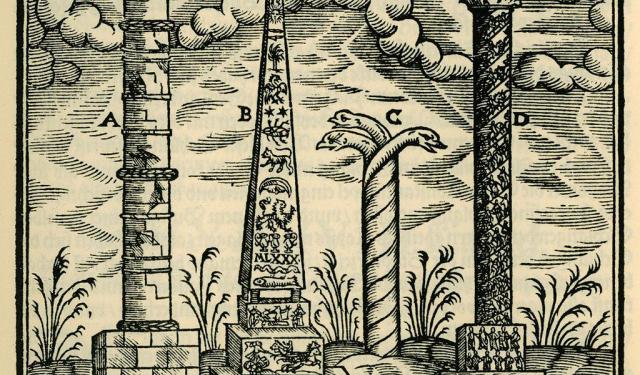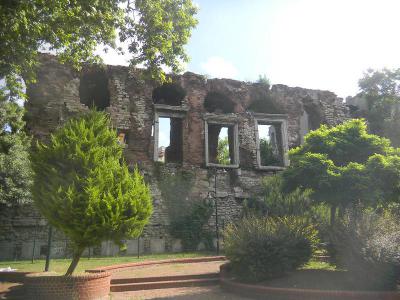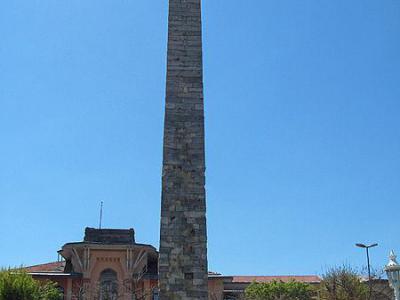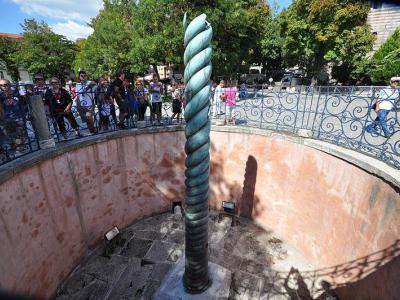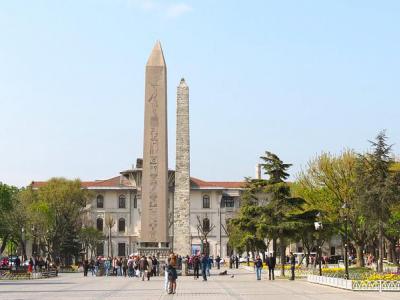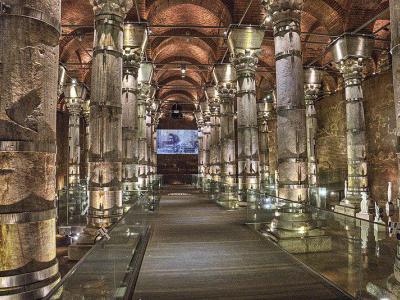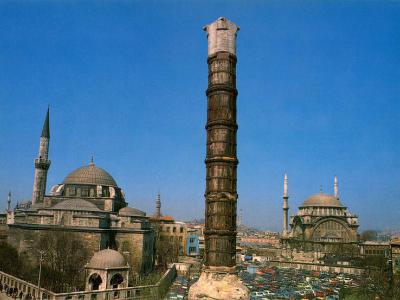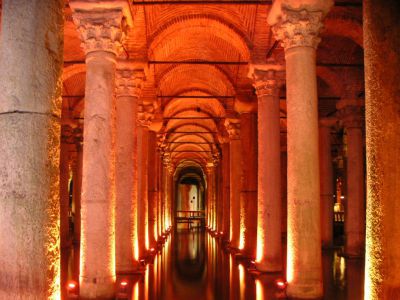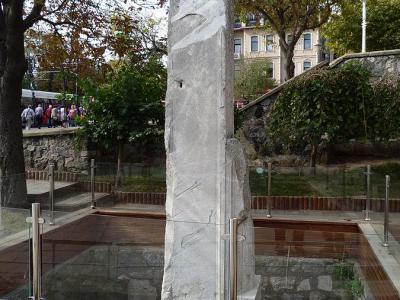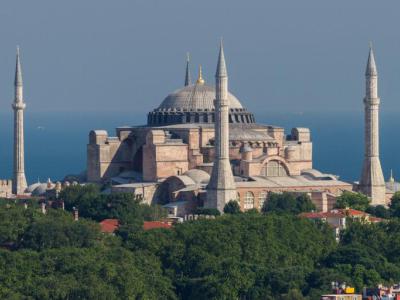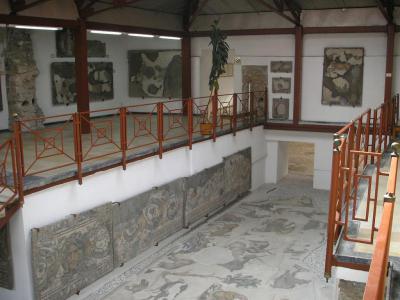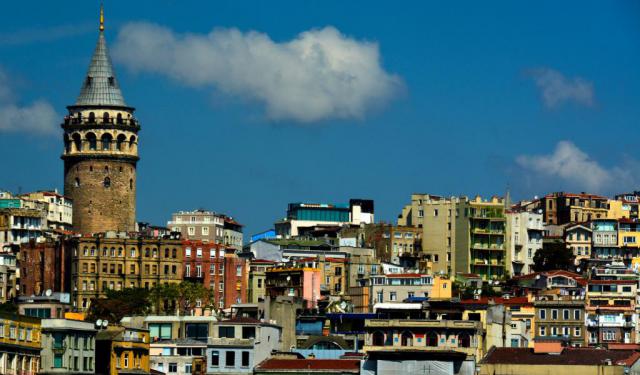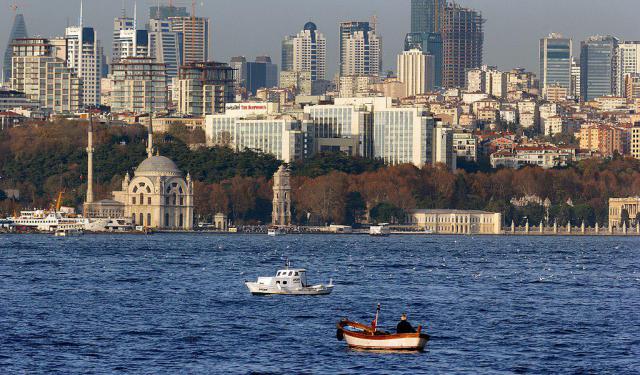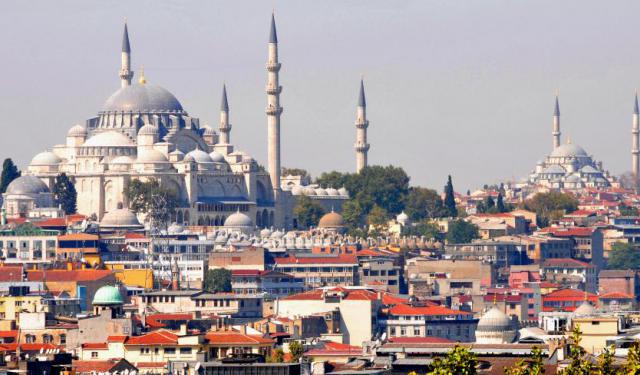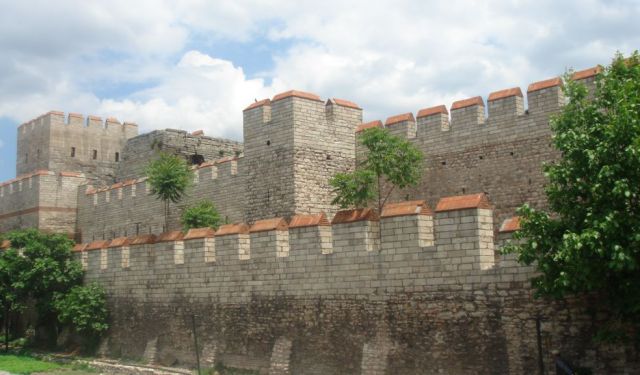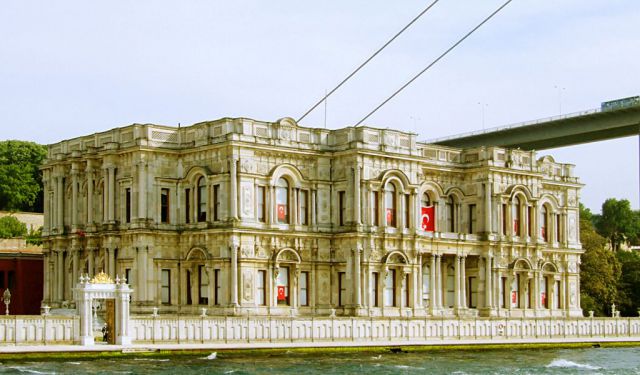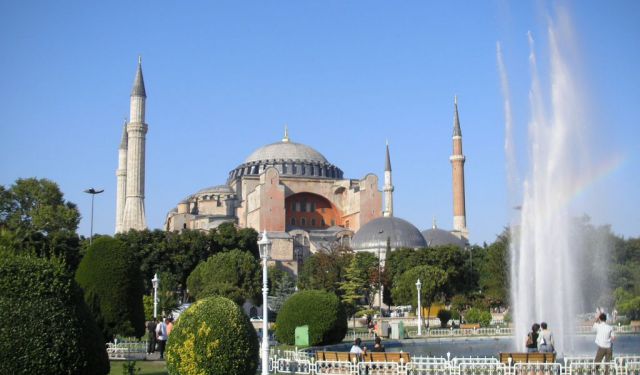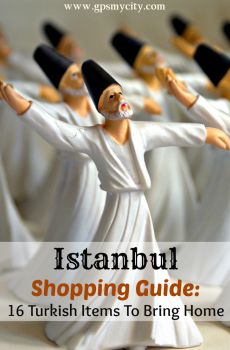Byzantine Heritage Walking Tour (Self Guided), Istanbul
Originated as a Greek city called Byzantium, what's now known as Istanbul initially made name as Constantinople, an Eastern Roman imperial capital whose greatness had lasted for over a millennium, from 330 AD until the Ottoman invasion in 1453.
The Byzantine Empire’s rich cultural and architectural heritage is still preserved in dazzling sites throughout the city. Away from its Islamic culture, some of Istanbul's imposing and hidden-away landmarks, from important museums to incredible architectural triumphs, are remnants of and testify to its Byzantine past.
The Theodosius Obelisk, the Serpent Column, and the Walled Obelisk are what's left of the former grandeur of the Hippodrome. Also known as Egyptian, for being imported from Egypt, the Obelisk of Theodosius is Istanbul’s oldest historical monument (dating back 3,500 years).
The center of Byzantine Istanbul was two squares: the Forum of Constantine and the Forum of Theodosius. The former plaza, built by Constantine the Great, has a porphyry column honoring the same emperor.
Basilica Cistern (Yerebatan Sarnıcı) – a subterranean wonder that seems like a flooded palace is certainly the biggest of the several hundred ancient cisterns found beneath the city.
Another one of great surviving Byzantine sites is the Stone of Million – a partially intact marble pillar, dating back to the 4th century AD; formerly the starting point of any distance measured within the Byzantine Empire.
After the Ottomans captured the city, many of its landmarks, especially churches, were converted to mosques. One such is Hagia Sophia (also known as Ayasofya), the world famous 6th-century hulking monolith, whose minarets (illuminated with spotlights at night) form an iconic part of Istanbul's skyline.
To have a glimpse of medieval Europe's most prestigious and flourishing city and to explore some of its most noteworthy historic locations, take this self-guided walking tour of the "crown jewel" of Byzantium.
The Byzantine Empire’s rich cultural and architectural heritage is still preserved in dazzling sites throughout the city. Away from its Islamic culture, some of Istanbul's imposing and hidden-away landmarks, from important museums to incredible architectural triumphs, are remnants of and testify to its Byzantine past.
The Theodosius Obelisk, the Serpent Column, and the Walled Obelisk are what's left of the former grandeur of the Hippodrome. Also known as Egyptian, for being imported from Egypt, the Obelisk of Theodosius is Istanbul’s oldest historical monument (dating back 3,500 years).
The center of Byzantine Istanbul was two squares: the Forum of Constantine and the Forum of Theodosius. The former plaza, built by Constantine the Great, has a porphyry column honoring the same emperor.
Basilica Cistern (Yerebatan Sarnıcı) – a subterranean wonder that seems like a flooded palace is certainly the biggest of the several hundred ancient cisterns found beneath the city.
Another one of great surviving Byzantine sites is the Stone of Million – a partially intact marble pillar, dating back to the 4th century AD; formerly the starting point of any distance measured within the Byzantine Empire.
After the Ottomans captured the city, many of its landmarks, especially churches, were converted to mosques. One such is Hagia Sophia (also known as Ayasofya), the world famous 6th-century hulking monolith, whose minarets (illuminated with spotlights at night) form an iconic part of Istanbul's skyline.
To have a glimpse of medieval Europe's most prestigious and flourishing city and to explore some of its most noteworthy historic locations, take this self-guided walking tour of the "crown jewel" of Byzantium.
How it works: Download the app "GPSmyCity: Walks in 1K+ Cities" from Apple App Store or Google Play Store to your mobile phone or tablet. The app turns your mobile device into a personal tour guide and its built-in GPS navigation functions guide you from one tour stop to next. The app works offline, so no data plan is needed when traveling abroad.
Byzantine Heritage Walking Tour Map
Guide Name: Byzantine Heritage Walking Tour
Guide Location: Turkey » Istanbul (See other walking tours in Istanbul)
Guide Type: Self-guided Walking Tour (Sightseeing)
# of Attractions: 10
Tour Duration: 2 Hour(s)
Travel Distance: 2.5 Km or 1.6 Miles
Author: DanaOffice
Sight(s) Featured in This Guide:
Guide Location: Turkey » Istanbul (See other walking tours in Istanbul)
Guide Type: Self-guided Walking Tour (Sightseeing)
# of Attractions: 10
Tour Duration: 2 Hour(s)
Travel Distance: 2.5 Km or 1.6 Miles
Author: DanaOffice
Sight(s) Featured in This Guide:
- Boukoleon Palace
- Walled Obelisk
- Serpent Column
- Obelisk of Theodosius (Egyptian Obelisk)
- Theodosius Cistern
- Column of Constantine
- Basilica Cistern (Yerebatan Sarnıcı)
- The Stone of Million
- Hagia Sophia (Ayasofya)
- Great Palace Mosaics Museum
1) Boukoleon Palace
Lying on the shore of the Marmara Sea in Istanbul, this was one of the city's first Byzantine Palaces, most probably built by Roman Emperor Theodosius II in the 5th century. Originally called Hormisdas, it was later named the Boukoleon (or Bucoleon) from a statue of a bull and a lion that stood the small harbor in front of the palace.
The known and still visible parts were added during the time of Emperor Theophilos (829-842), who greatly expanded and renovated the structure, adding a 300m-long façade on top of the sea-facing walls. It would remain the main palace for the Byzantine court until the 11th century with the construction of the Palace of Blachernae by the Komnenos dynasty.
In the 1204 sacking of Constantinople during the Fourth Crusade, Boukoleon was taken by Boniface of Montferrat who found in it treasures "beyond end or counting." Among his prizes was also Empress Margaret, daughter of Bela III of Hungary, who took refuge at the palace and whom Boniface eventually married.
In 2018, it was announced by the Istanbul Metropolitan Municipality that the palace would be restored by the Cultural and Natural Heritage Conservation Board, with plans to develop it into an open-air museum with "a timber walking trail for visitors, a museum, and a pool." Until that time comes, the ruins are temporarily protected by fences.
The known and still visible parts were added during the time of Emperor Theophilos (829-842), who greatly expanded and renovated the structure, adding a 300m-long façade on top of the sea-facing walls. It would remain the main palace for the Byzantine court until the 11th century with the construction of the Palace of Blachernae by the Komnenos dynasty.
In the 1204 sacking of Constantinople during the Fourth Crusade, Boukoleon was taken by Boniface of Montferrat who found in it treasures "beyond end or counting." Among his prizes was also Empress Margaret, daughter of Bela III of Hungary, who took refuge at the palace and whom Boniface eventually married.
In 2018, it was announced by the Istanbul Metropolitan Municipality that the palace would be restored by the Cultural and Natural Heritage Conservation Board, with plans to develop it into an open-air museum with "a timber walking trail for visitors, a museum, and a pool." Until that time comes, the ruins are temporarily protected by fences.
2) Walled Obelisk
The Walled Obelisk, also known by names such as the Constantine Obelisk or the Masonry Obelisk, is a historical monument located at the south end of what was once the Hippodrome of Constantinople, now known as Sultanahmet Square in Istanbul. This area is a major tourist attraction, not only because of the obelisk itself but also due to its proximity to other famous landmarks including the Egyptian Obelisk, the German Fountain, and iconic structures like the Hagia Sophia and Blue Mosque.
The exact date of the Walled Obelisk's original construction remains a mystery. However, it underwent significant reconstruction in the 10th century under the directive of Emperor Constantine VII. This reconstruction effort saw the 32-meter (approximately 105 feet) tall structure being rebuilt with roughly cut stones. During this period, it was adorned with gilded bronze plaques that showcased the military triumphs of Basil I, who was Constantine VII's grandfather. A sphere placed atop the obelisk added to its grandeur.
Unfortunately, the Walled Obelisk's splendor was not to last. In 1204, during the Fourth Crusade, the obelisk was plundered, with its gilded bronze plaques being stolen and melted down. Adding to its woes, the obelisk also suffered surface damage inflicted by young Janissaries, members of the Ottoman Sultan's household troops, who would climb the monument to demonstrate their agility and strength.
Despite these challenges, the Walled Obelisk has endured through the centuries and continues to be a point of interest for countless tourists visiting Istanbul. Its historical significance and the stories of its past make it a captivating sight for those looking to delve into the rich history of one of the world's most historically significant cities.
The exact date of the Walled Obelisk's original construction remains a mystery. However, it underwent significant reconstruction in the 10th century under the directive of Emperor Constantine VII. This reconstruction effort saw the 32-meter (approximately 105 feet) tall structure being rebuilt with roughly cut stones. During this period, it was adorned with gilded bronze plaques that showcased the military triumphs of Basil I, who was Constantine VII's grandfather. A sphere placed atop the obelisk added to its grandeur.
Unfortunately, the Walled Obelisk's splendor was not to last. In 1204, during the Fourth Crusade, the obelisk was plundered, with its gilded bronze plaques being stolen and melted down. Adding to its woes, the obelisk also suffered surface damage inflicted by young Janissaries, members of the Ottoman Sultan's household troops, who would climb the monument to demonstrate their agility and strength.
Despite these challenges, the Walled Obelisk has endured through the centuries and continues to be a point of interest for countless tourists visiting Istanbul. Its historical significance and the stories of its past make it a captivating sight for those looking to delve into the rich history of one of the world's most historically significant cities.
3) Serpent Column
To raise the image of his new capital, Constantine and his successors, especially Theodosius the Great, brought works of art from all over the empire to adorn it. The monuments were set up in the middle of the Hippodrome, the spina. Among these was the Tripod of Plataea, now known as the Serpent Column, cast to celebrate the victory of the Greeks over the Persians during the Persian Wars in the 5th century BC. Together with its original golden tripod and cauldron (both long missing), it constituted a trophy or offering reminding of a military victory, dedicated to Apollo.
Constantine ordered the Tripod to be moved from the Temple of Apollo at Delphi and set in the middle of the Hippodrome. While it appears that the golden cauldron was never brought to Constantinople, the serpent heads and top third of the column were destroyed in 1700; parts of the heads were recovered and are displayed at the Istanbul Archaeology Museum.
All that remains of the monument today is the base, located near the Walled Obelisk and the Egyptian Column in Sultanahmet Square, a popular tourist spot in Istanbul.
Tip:
The column in its complete form is depicted in several paintings on display at the nearby Hagia Sofia.
Constantine ordered the Tripod to be moved from the Temple of Apollo at Delphi and set in the middle of the Hippodrome. While it appears that the golden cauldron was never brought to Constantinople, the serpent heads and top third of the column were destroyed in 1700; parts of the heads were recovered and are displayed at the Istanbul Archaeology Museum.
All that remains of the monument today is the base, located near the Walled Obelisk and the Egyptian Column in Sultanahmet Square, a popular tourist spot in Istanbul.
Tip:
The column in its complete form is depicted in several paintings on display at the nearby Hagia Sofia.
4) Obelisk of Theodosius (Egyptian Obelisk)
Meet one of Sultanahmet’s oldest landmarks — the Obelisk of Theodosius (though technically it’s far more Egyptian than Constantinopolitan). This stone needle was commissioned by Pharaoh Thutmose III back in the 15th century BC to brag about a victory over the Mitanni near the Euphrates. Imagine ancient political propaganda — but carved in granite and meant to last longer than any press release ever could...
Now, before you admire its height, here’s the twist: you’re only looking at the top third of the original monument. The whole thing once stood in the grand temple of Karnak, until the Romans decided they wanted a piece of it — quite literally. So, they chopped it up, floated it down the Nile to Alexandria in 390 AD, and then shipped it off again to Constantinople, where Emperor Theodosius set it up as his own imperial victory souvenir. Indeed, there's nothing like redecorating an empire to celebrate your 20th anniversary on the throne...
Take a good look at the pedestal holding it up. You’ll see the scenes of Theodosius sitting in the Hippodrome’s imperial box — the Kathisma — handing out victory wreaths as if he invented winning as such. Meanwhile, the obelisk itself, despite its age of nearly 3,500 years, still looks as good as new.
So, if you’re wandering through Sultanahmet Square, don’t just rush between the Blue Mosque and Hagia Sophia. Stop by and say hello to this time-traveling monument. It’s tall, it’s ancient, and it has more drama in its backstory than most streaming series.
Now, before you admire its height, here’s the twist: you’re only looking at the top third of the original monument. The whole thing once stood in the grand temple of Karnak, until the Romans decided they wanted a piece of it — quite literally. So, they chopped it up, floated it down the Nile to Alexandria in 390 AD, and then shipped it off again to Constantinople, where Emperor Theodosius set it up as his own imperial victory souvenir. Indeed, there's nothing like redecorating an empire to celebrate your 20th anniversary on the throne...
Take a good look at the pedestal holding it up. You’ll see the scenes of Theodosius sitting in the Hippodrome’s imperial box — the Kathisma — handing out victory wreaths as if he invented winning as such. Meanwhile, the obelisk itself, despite its age of nearly 3,500 years, still looks as good as new.
So, if you’re wandering through Sultanahmet Square, don’t just rush between the Blue Mosque and Hagia Sophia. Stop by and say hello to this time-traveling monument. It’s tall, it’s ancient, and it has more drama in its backstory than most streaming series.
5) Theodosius Cistern
One of many ancient cisterns of Constantinople that lie beneath the city of Istanbul, the Theodosius Cistern – built by Roman Emperor Theodosius II between 428 and 443 – was once part of the city's 250-kilometers-long water supply system. Like the Basilica and Binbirdirek cisterns, it is once again open to the public, having undergone an eight-year renovation.
Although a visit here doesn't take long, it is worth seeing and hearing the history behind the place and how people used to store water in the olden days. A wonderful example of Roman ingenuity, the cistern is well-lit and beautifully taken care of. They also added sound effects which really make the whole experience much better, and there are even some artworks and historical handmade Turkish rugs on display. All in all, one of the most interesting and relaxing places in Istanbul!
Tip:
Use the stairs to get nice views from above the columns, and stop by Ruby Ceramics & Gift Shop across the road – you won't regret it!
Although a visit here doesn't take long, it is worth seeing and hearing the history behind the place and how people used to store water in the olden days. A wonderful example of Roman ingenuity, the cistern is well-lit and beautifully taken care of. They also added sound effects which really make the whole experience much better, and there are even some artworks and historical handmade Turkish rugs on display. All in all, one of the most interesting and relaxing places in Istanbul!
Tip:
Use the stairs to get nice views from above the columns, and stop by Ruby Ceramics & Gift Shop across the road – you won't regret it!
6) Column of Constantine
The monumental Column of Constantine was constructed on the orders of the Roman emperor Constantine the Great in 330 AD to commemorate the declaration of Byzantium as the new capital city of the Roman Empire.
Located along the old Road to the Imperial Council between the Hippodrome of Constantinople (now Sultanahmet Square) and the Forum of Theodosius (now Beyazıt Square), the column was 50 meters tall on its erection and had the statue of Constantine (in the figure of Apollo) carrying an orb that allegedly contained a fragment of the True Cross. At the foot of the column was a sanctuary which contained even more relics, allegedly from the crosses of the two thieves who were crucified with Jesus Christ at Calvary, the baskets from the loaves and fishes miracle, an alabaster ointment jar belonging to Mary Magdalene and used by her for anointing the head and feet of Jesus, and a wooden statue of Pallas Athena from Troy.
A strong gale in 1106 AD felled the statue and three of the column's upper cylinders. Some years later, Byzantine emperor Manuel I Komnenos (reigned 1143-1180) placed a cross on top in place of the original statue and added a commemorative inscription that read "Faithful Manuel invigorated this holy work of art, which has been damaged by time". Bronze wreaths once covered the joints between the drums, but these were taken by the Latin Crusaders who plundered the city during the Fourth Crusade in 1204. The cross was removed by the Ottoman Turks after the fall of Constantinople in 1453.
Earthquakes and a fire in 1779 destroyed the neighborhood surrounding the column, leaving it with black scorch marks and earning it the name 'Burnt Column'. It was then restored by Sultan Abdülhamid I, who had the present masonry base added. The column's original platform is 2.5 meters (about 8 feet) below ground.
Located along the old Road to the Imperial Council between the Hippodrome of Constantinople (now Sultanahmet Square) and the Forum of Theodosius (now Beyazıt Square), the column was 50 meters tall on its erection and had the statue of Constantine (in the figure of Apollo) carrying an orb that allegedly contained a fragment of the True Cross. At the foot of the column was a sanctuary which contained even more relics, allegedly from the crosses of the two thieves who were crucified with Jesus Christ at Calvary, the baskets from the loaves and fishes miracle, an alabaster ointment jar belonging to Mary Magdalene and used by her for anointing the head and feet of Jesus, and a wooden statue of Pallas Athena from Troy.
A strong gale in 1106 AD felled the statue and three of the column's upper cylinders. Some years later, Byzantine emperor Manuel I Komnenos (reigned 1143-1180) placed a cross on top in place of the original statue and added a commemorative inscription that read "Faithful Manuel invigorated this holy work of art, which has been damaged by time". Bronze wreaths once covered the joints between the drums, but these were taken by the Latin Crusaders who plundered the city during the Fourth Crusade in 1204. The cross was removed by the Ottoman Turks after the fall of Constantinople in 1453.
Earthquakes and a fire in 1779 destroyed the neighborhood surrounding the column, leaving it with black scorch marks and earning it the name 'Burnt Column'. It was then restored by Sultan Abdülhamid I, who had the present masonry base added. The column's original platform is 2.5 meters (about 8 feet) below ground.
7) Basilica Cistern (Yerebatan Sarnıcı) (must see)
Deep beneath the busy streets near Hagia Sophia lies one of Istanbul’s coolest secrets — literally — the Basilica Cistern. Its Turkish name, translating to something like “the cistern that sank into the ground,” sounds dramatic… and honestly, it lives up to the hype. Built in the 6th century AD by Emperor Justinian I, this underground wonder once helped supply water to the Great Palace of Constantinople. And yes, history tells us, more than 7,000 slaves worked on it, which in turn explains how it became so massive.
The endless rows of columns, dim lighting, and still water reflecting everything like a spooky mirror... If this feels a bit like stepping into a fantasy movie set, that’s because thousands of years ago, the Byzantines were already masters of atmospheric design. Even when the Ottomans took over, the cistern kept doing its job quietly — providing water to Topkapi Palace and proving itself far more reliable than your average plumbing system.
These days, the Basilica Cistern is less about water supply and more about blowing visitors’ minds. You can stroll past ancient triumphal arches, admire rows of marble pillars, and, of course, meet the most famous residents: two giant Medusa heads casually holding up columns in the northwest corner. One sideways, one upside-down… because when you have mythological monster heads lying around, why not get creative?
And if you like incredible photos, mysterious echoes, and that thrilling “did I just feel a ghost breeze?” vibe — this place delivers. Plus, it’s right next to Hagia Sophia, Topkapi Palace, and the Blue Mosque, so you can easily squeeze it into your ancient-monument marathon.
A word of warning: surfaces can get slippery — especially around Medusa — so walk like you’re in a suspense movie. And also bring a jacket, for it gets rather chilly underground... Ready to descend into Istanbul’s past? The cistern is waiting below… just mind the water.
The endless rows of columns, dim lighting, and still water reflecting everything like a spooky mirror... If this feels a bit like stepping into a fantasy movie set, that’s because thousands of years ago, the Byzantines were already masters of atmospheric design. Even when the Ottomans took over, the cistern kept doing its job quietly — providing water to Topkapi Palace and proving itself far more reliable than your average plumbing system.
These days, the Basilica Cistern is less about water supply and more about blowing visitors’ minds. You can stroll past ancient triumphal arches, admire rows of marble pillars, and, of course, meet the most famous residents: two giant Medusa heads casually holding up columns in the northwest corner. One sideways, one upside-down… because when you have mythological monster heads lying around, why not get creative?
And if you like incredible photos, mysterious echoes, and that thrilling “did I just feel a ghost breeze?” vibe — this place delivers. Plus, it’s right next to Hagia Sophia, Topkapi Palace, and the Blue Mosque, so you can easily squeeze it into your ancient-monument marathon.
A word of warning: surfaces can get slippery — especially around Medusa — so walk like you’re in a suspense movie. And also bring a jacket, for it gets rather chilly underground... Ready to descend into Istanbul’s past? The cistern is waiting below… just mind the water.
8) The Stone of Million
Don't be surprised if they say, you’re now standing at what used to be the center of the world. Not metaphorically—the actual center, according to the Byzantines. The Stone of Million, this humble remnant before you, once marked Zero Mile for the entire empire. Want to know how far it was to Thessaloniki, Antioch, or Rome? The answer started right here. It was Constantinople’s way of saying, “All roads lead to us—thanks for acknowledging it.”
Back in the 4th century, this wasn’t just a stone stub. It was a flashy double triumphal arch topped with a dome, supported by four arches, and crowned with statues of Emperor Constantine and his mother Helena—posing confidently with a cross and staring eastward, as if waiting for applause. Behind them stood Tyche, the goddess of good fortune, presumably making sure the city stayed fabulous.
And get this: long before the world cared about Greenwich, Istanbul was Time Zero. Literally. The global meridian was drawn through the Million’s location. If you set a clock in Paris or Cairo, the time traced back here—Constantinople kept everyone punctual. Maps pointed to this exact spot to tell sailors where "home" really was.
Then came 1884. A bunch of delegates gathered at the International Meridian Conference and said, “Actually… what if we made England the middle?” Just like that, Greenwich got the glory, and the Million Stone was demoted from world anchor to historical footnote.
Yet it still sits proudly in Sultanahmet, quietly reminding us that this was once the center of everything...
So, take a moment. You’re not just visiting a stone—you’re standing on the coordinates where empires measured distance, time, and importance. Not bad for one little marker holding onto its superstar past...
Back in the 4th century, this wasn’t just a stone stub. It was a flashy double triumphal arch topped with a dome, supported by four arches, and crowned with statues of Emperor Constantine and his mother Helena—posing confidently with a cross and staring eastward, as if waiting for applause. Behind them stood Tyche, the goddess of good fortune, presumably making sure the city stayed fabulous.
And get this: long before the world cared about Greenwich, Istanbul was Time Zero. Literally. The global meridian was drawn through the Million’s location. If you set a clock in Paris or Cairo, the time traced back here—Constantinople kept everyone punctual. Maps pointed to this exact spot to tell sailors where "home" really was.
Then came 1884. A bunch of delegates gathered at the International Meridian Conference and said, “Actually… what if we made England the middle?” Just like that, Greenwich got the glory, and the Million Stone was demoted from world anchor to historical footnote.
Yet it still sits proudly in Sultanahmet, quietly reminding us that this was once the center of everything...
So, take a moment. You’re not just visiting a stone—you’re standing on the coordinates where empires measured distance, time, and importance. Not bad for one little marker holding onto its superstar past...
9) Hagia Sophia (Ayasofya) (must see)
Hagia Sophia is the ultimate overachiever of both architecture and religion. Built in the 6th century for Emperor Justinian I, it began life as a grand Christian cathedral—basically the power seat of the Eastern Orthodox world. Its giant dome was such an engineering feat that people said it hung from heaven by a chain. At 180 feet tall and 100 feet wide, it still gets a lot of impressed neck-craning today.
Still, history wasn’t satisfied with just one identity for Hagia Sophia. When the Ottomans conquered Constantinople in 1453, Sultan Mehmed II turned it into a mosque. Up went the minarets, out came the church bells, and Christian images were masterly covered—like someone switching décor for a very different house party... Today, you’ll see a fascinating mash-up: Islamic calligraphy panels right beside shimmering mosaics of the Virgin Mary and Jesus. History lesson and cultural fusion rolled into one.
Inside, look for the famous Deësis mosaic from the 13th century, featuring Christ, John the Baptist, and the Virgin Mary, expressing emotion so well it almost feels like they’re watching you back. And don’t miss the “wishing column.” Legend says that if you stick your thumb in the little hole and rotate it just right, you get a miracle. Rumor has it, even Emperor Justinian tried it for headaches—indeed, who needs aspirin when you have ancient architecture?
Recognized as a UNESCO World Heritage Site, Hagia Sophia continues to reinvent itself. After a stretch as a museum, it has returned to its original mission as a place of worship, while its historical displays now live at the nearby Ibrahim Pasha Palace.
Indeed, one shouldn't miss the opportunity to visit here, because where else can you stand in one spot and admire 1,500 years of spiritual remixing? Hagia Sophia’s layers of faith, art, and genius design make it impossible to look away—so go ahead and stare in awe!
Still, history wasn’t satisfied with just one identity for Hagia Sophia. When the Ottomans conquered Constantinople in 1453, Sultan Mehmed II turned it into a mosque. Up went the minarets, out came the church bells, and Christian images were masterly covered—like someone switching décor for a very different house party... Today, you’ll see a fascinating mash-up: Islamic calligraphy panels right beside shimmering mosaics of the Virgin Mary and Jesus. History lesson and cultural fusion rolled into one.
Inside, look for the famous Deësis mosaic from the 13th century, featuring Christ, John the Baptist, and the Virgin Mary, expressing emotion so well it almost feels like they’re watching you back. And don’t miss the “wishing column.” Legend says that if you stick your thumb in the little hole and rotate it just right, you get a miracle. Rumor has it, even Emperor Justinian tried it for headaches—indeed, who needs aspirin when you have ancient architecture?
Recognized as a UNESCO World Heritage Site, Hagia Sophia continues to reinvent itself. After a stretch as a museum, it has returned to its original mission as a place of worship, while its historical displays now live at the nearby Ibrahim Pasha Palace.
Indeed, one shouldn't miss the opportunity to visit here, because where else can you stand in one spot and admire 1,500 years of spiritual remixing? Hagia Sophia’s layers of faith, art, and genius design make it impossible to look away—so go ahead and stare in awe!
10) Great Palace Mosaics Museum
Tucked just behind the majestic Blue Mosque — or actually under it — the Museum of Great Palace Mosaics is one of Istanbul’s best surprises waiting beneath your feet. Hidden below the Arasta Bazaar, this two-level gallery shelters what was once the glittering floor of the Byzantine Great Palace. If you’ve already swooned over the mosaics in Hagia Sophia or the Chora Church, brace yourself: there’s more ancient eye-candy down here.
These mosaics may have lost their palace, but not their flair. Crafted around 450–550 AD, about 40,000 tiny pieces of limestone, earthenware, and colorful stone once covered a sprawling (over 1,800-square-meter) courtyard in Constantine the Great’s imperial residence — centuries before the Ottomans thought up the Blue Mosque next door.
In the 7th and 8th centuries, when painting was frowned upon, the entire mosaic carpet was buried under heavy marble slabs and sealed away (like a time capsule nobody remembered). Under the Ottomans, the palaces were moved to the Golden Horn (to avoid potential threat from the sea), and later the entire neighborhood was turned into a residential district. They unknowingly built homes right over this ancient masterpiece, and everyone just walked on top of it for centuries, completely oblivious.
It wasn't until 1921, when a fire ripped through the area, that the excavation works that followed cracked the ground open, and suddenly — surprise! — a forgotten palace floor showed up. Archaeologists, mostly from the University of St Andrews in Scotland, spent decades (from 1935 to 1951) carefully unearthing it, piecing together the world’s most precious jigsaw puzzle.
Today, the mosaics remain almost exactly where they were rediscovered, still bursting with life. You’ll meet more than 150 figures: hunters chasing wild beasts, kids riding exotic animals, mythological characters acting dramatic — basically, a highly illustrated Byzantine “Instagram” feed...
Finally granted museum status in 1997, this site is one of Istanbul’s most exciting archaeological wins of the modern era — and a thrilling reminder that in this city, history isn’t just around every corner… sometimes it’s right under your very shoes.
These mosaics may have lost their palace, but not their flair. Crafted around 450–550 AD, about 40,000 tiny pieces of limestone, earthenware, and colorful stone once covered a sprawling (over 1,800-square-meter) courtyard in Constantine the Great’s imperial residence — centuries before the Ottomans thought up the Blue Mosque next door.
In the 7th and 8th centuries, when painting was frowned upon, the entire mosaic carpet was buried under heavy marble slabs and sealed away (like a time capsule nobody remembered). Under the Ottomans, the palaces were moved to the Golden Horn (to avoid potential threat from the sea), and later the entire neighborhood was turned into a residential district. They unknowingly built homes right over this ancient masterpiece, and everyone just walked on top of it for centuries, completely oblivious.
It wasn't until 1921, when a fire ripped through the area, that the excavation works that followed cracked the ground open, and suddenly — surprise! — a forgotten palace floor showed up. Archaeologists, mostly from the University of St Andrews in Scotland, spent decades (from 1935 to 1951) carefully unearthing it, piecing together the world’s most precious jigsaw puzzle.
Today, the mosaics remain almost exactly where they were rediscovered, still bursting with life. You’ll meet more than 150 figures: hunters chasing wild beasts, kids riding exotic animals, mythological characters acting dramatic — basically, a highly illustrated Byzantine “Instagram” feed...
Finally granted museum status in 1997, this site is one of Istanbul’s most exciting archaeological wins of the modern era — and a thrilling reminder that in this city, history isn’t just around every corner… sometimes it’s right under your very shoes.
Walking Tours in Istanbul, Turkey
Create Your Own Walk in Istanbul
Creating your own self-guided walk in Istanbul is easy and fun. Choose the city attractions that you want to see and a walk route map will be created just for you. You can even set your hotel as the start point of the walk.
Old European Quarter Walk
Back in the Ottoman era, the Beyoğlu neighborhood (then known as Pera), together with Galata, formed the stylish European Quarter of Istanbul. Home to embassies, trading houses, and Parisian-style apartment blocks, it all looks like it wandered in straight from the French capital. This area was where the city’s non-Islamic communities worked, lived, and possibly argued over the best pastries...... view more
Tour Duration: 2 Hour(s)
Travel Distance: 2.4 Km or 1.5 Miles
Tour Duration: 2 Hour(s)
Travel Distance: 2.4 Km or 1.5 Miles
Bosphorus Coast Walking Tour
One of the planet's most praised stretches of water, the Bosphorus is a source of great pride for Istanbulites and of admiration for travelers. The 30-km strait dividing Europe and Asia and connecting the Marmara with the Black Sea is one of the city's highlights, having been for all ages the subject of legend and art.
This self-guided walk will take you along the coast so that you... view more
Tour Duration: 3 Hour(s)
Travel Distance: 5.9 Km or 3.7 Miles
This self-guided walk will take you along the coast so that you... view more
Tour Duration: 3 Hour(s)
Travel Distance: 5.9 Km or 3.7 Miles
Istanbul Old City Walking Tour
The Old City of Istanbul, occupying a triangular peninsula between the Golden Horn and the Sea of Marmara, is one of the most historically layered urban areas in the world. Its evolution reflects a succession of empires that shaped its architecture, culture, and spiritual life. The city’s origins date to around 657 BC, when Greek settlers from Megara founded Byzantium for its ideal harbor and... view more
Tour Duration: 2 Hour(s)
Travel Distance: 2.3 Km or 1.4 Miles
Tour Duration: 2 Hour(s)
Travel Distance: 2.3 Km or 1.4 Miles
Istanbul City Walls
One of the most elaborate fortification systems of ancient times, the Walls of Constantinople were built by Constantine the Great to protect the city, the then newly-established capital of the Eastern Roman Empire, from attacks by land and sea. Of these, only the Golden Gate, an old ceremonial gateway into the city, had survived by the late Byzantine Era when a new series of land walls were added... view more
Tour Duration: 2 Hour(s)
Travel Distance: 5.2 Km or 3.2 Miles
Tour Duration: 2 Hour(s)
Travel Distance: 5.2 Km or 3.2 Miles
Asian Side and Bosphorus Walking Tour
Istanbul is the only megalopolis in the world that straddles two continents. The Bosphorus Strait splits Turkey's biggest city into two parts: European and Asian. The latter, known locally as Asya Yakası (“Asian Side”), or more commonly as Anadolu Yakası (“Anatolian Side”), is found east of the strait, geographically on the Asian mainland.
The vast Anatolian shore, wrongly... view more
Tour Duration: 2 Hour(s)
Travel Distance: 4.6 Km or 2.9 Miles
The vast Anatolian shore, wrongly... view more
Tour Duration: 2 Hour(s)
Travel Distance: 4.6 Km or 2.9 Miles
Istanbul Introduction Walking Tour
Once called Byzantium, Constantinople, and New Rome, Istanbul has had more name changes over the years than a celebrity avoiding paparazzi... The largest city in Turkey and one of the world’s most historic urban centers, it straddles the Bosphorus Strait like it couldn’t decide whether to sit on its European or Asian side and ultimately opted for both. The result was a cultural smoothie... view more
Tour Duration: 2 Hour(s)
Travel Distance: 4.3 Km or 2.7 Miles
Tour Duration: 2 Hour(s)
Travel Distance: 4.3 Km or 2.7 Miles
Useful Travel Guides for Planning Your Trip
Istanbul Shopping Guide: 16 Turkish Items To Bring Home
Istanbul, known throughout history as Byzantium and Constantinople, has been a major center of commerce and trade, a place where merchants and general folk would rush to regularly in search of exotic things. In our days, modern travelers to Istanbul are also bound to enjoy a truly magnificent...
The Most Popular Cities
/ view all
